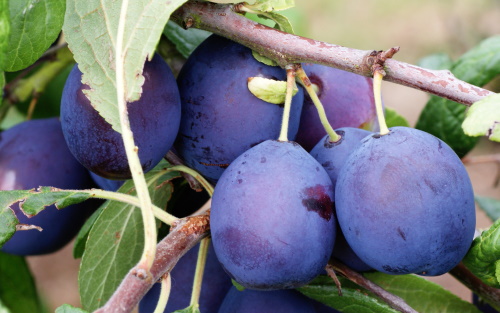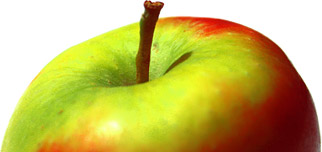Merryweather damson

Merryweather is one of the most widely-grown of all damson varieties, being easy to grow, and producing good crops of classic damson-flavoured fruit.
Inspite of this popularity, some authorities question whether Merryweather is a true damson since it has many plum-like characteristics. H.V. Taylor in his definitive book "The plums of England" considered it as a hybrid damson / plum - but went on to say he felt it was probably the best of all damsons for gardeners.
By damson standards the fruit is large - more like a small plum in fact. Merryweather grows like a plum too, with a spreading habit rather than the more vertical habit often seen in damsons. It also comes into bearing earlier in its life than most damsons. Again unusually for a damson, the fruit can be eaten fresh if left to hang on the tree - although, like all damsons its true home is in the kitchen where it is one of the most versatile of culinary fruits.
Inspite of this interesting debate about its origins, Merryweather can be classed as a true damson for a simple reason - it has the distinctive astringent flavour which is the hallmark of the damson. Like most damsons it is also a hardy tree, in fact Merryweather is a tough tree even by damson standards and can thrive in very difficult situations.
Merryweather damson identification images
All images copyright Orange Pippin unless otherwise stated.
USDA identification images for Merryweather
The identification paintings in the USDA Pomological Watercolor Collection span the years 1886 to 1942.
Citation: U.S. Department of Agriculture Pomological Watercolor Collection. Rare and Special Collections, National Agricultural Library, Beltsville, MD 20705.
Visitor reviews
- 26 Sep 2013 TahirUnited KingdomA great damson, much bigger than most and really pleasant as a dessert plum as long as it's really ripe. Bit of a pain for jam as it's VERY clingstone, nice flavour especially for people that find something ;like Farleighs too intense
Tree register
United States
- Mike in Glen Rock, PA
United Kingdom
- Reach Community Orchard in Cambridge,
- Reach Community Orchard in Cambridge,
- Reach Community Orchard in Cambridge,
- Alison Quinsey in Beccles, SUFFOLK
- Alison Underwood in Colwyn Bay, NORTH WALES
- Andy in Surrey,
- Angela Bogle in Bakewell, DERBYSHIRE
- Ann Davis in Sutton, MACCLESFIELD
- Anthony Payne in Bath,
- Billy Auger in Hopton Wafers, SHROPSHIRE
- Bilsen in Leeds,
- Charlie Barrass in GREAT BIRCHAM, NORFOLK
- Christopher Davidson in BADRALLACH, HIGHLANDS
- Clifford Cain in Bawtry, Doncaster, SOUTH YORKSHIRE
- David Harmston in Sleaford, LINCS
- David Haynes in Catterall, LANCASHIRE
- David Scarle in Nottingham,
- Davidjohndawkins in Ely, CAMBS
- Deborah Kaufmann in Hyde,
- Deborah Kaufmann in Mossley,
- Dr Mairi Rennie in Petersfield, WEST SUSSEX
- Eileen Brown in Blairgowrie, PERTH AND KINROSS
- Freyja Burrill in Kings Meaburn/ Penrith, CUMBRIA
- Geoffrey Brown in Grundisburgh, SUFFOLK
- Henryc in Andover, HAMPSHIRE
- Ian Hindley in WARMINGTON, NORTHAMPTONSHIRE
- James Kidd in Hightae, DUMFRIES AND GALLOWAY
- James Kidd in Hightae, DUMFRIES AND GALLOWAY
- Jane Cannig in Evesham,, WORCESTERSHIRE.
- Jean Lippett in Martock, SOMERSET
- John Adams in Alvechurch, WEST MIDLANDS
- Lawrence Wilson in Mayfield, EAST SUSSEX
- Linda Downes in CARNFORTH,
- M. Salisbury in Preston, LANCS
- margaret in Stonehaven,
- Mark in Chippenham, WILTS
- Mark Davies in Saddleworth, YORKSHIRE
- Michael Adams in Halifax, WEST YORKSHIRE
- Michele Young in Bath, AVON
- Nickkk in Oldham, LANCASHIRE
- Peter Revell in Hemel Hempstead, HERTS
- Peter Tyler in Eye, SUFFOLK
- Peter Tyler in Eye, SUFFOLK
- Philip Wray in Andover, HAMPSHIRE
- Rachel in Downham Market, NORFOLK
- Sally in DERBYSHIRE
- Tony in Glasgow, SCOTLAND
- Victoria Birkett in Aberdeen, SCOTLAND
Poland
- Robin Thompson in Mirsk, DOLNY SLASK
- Robin Thompson in Mirsk, DOLNY SLASK
Spring blossom records for this variety
2015 season
- 19th April 2015 - tree owned by Michael in Halifax, United Kingdom
2014 season
- 25th April 2014 - tree owned by Lawrence in Mayfield, United Kingdom
- 19th April 2014 - tree owned by Michael in Halifax, United Kingdom
2012 season
- 13th April 2012 - tree owned by Peter in Eye, United Kingdom
- 13th April 2012 - tree owned by Nickkk in Oldham, United Kingdom
- 24th March 2012 - tree owned by Mike in Glen Rock, United States
2011 season
- 15th April 2011 - tree owned by Davidjohndawkins in Ely, United Kingdom
- 4th April 2011 - tree owned by David in Sleaford, United Kingdom
- 28th March 2011 - tree owned by Rachel in Downham Market, United Kingdom
- 20th March 2011 - tree owned by Dr in Petersfield, United Kingdom
Record your blossom dates in our Fruit Tree Register - more >>.
Harvest records for this variety
Origins
- Species: Prunus insititia - Damson, Mirabelle, Bullace
- Originates from: Southwell, Nottinghamshire, United Kingdom
- Introduced: 1907
- Developed by: Messrs. Merryweather (nuserymen)
Identification
- Country of origin: United Kingdom
- Period of origin: 1900 - 1949
- Fruit colour: Blue - dark
- Flower colour: White
- Leaf colour: Green
- Popularity: Best sellers
- Annual cycle: Deciduous
Using
- Cling-stone: Clingstone
- Picking season: Mid
- Keeping (of fruit): 1 week
- Flavour quality: Good
- Cropping: Heavy
- Fruit persistence: Normal ripening
- Food uses: Culinary
- Picking period: mid-September
- Wildlife: RHS Plants for Pollinators
Growing
- Gardening skill: Beginner
- Flowering group: 3
- Pollinating others: Average
- Vigour: Vigorous
- Bearing regularity: Regular
- Organic culture: Suitable
- Self-fertility: Self-fertile
Climate
- Climate suitability: Temperate climates
- Climate suitability: Mild damp climates
- Summer average maximum temperatures: Cool ( 20-24C / 68-75F)
- Summer average maximum temperatures: Warm (25-30C / 76-85F)
- Summer average maximum temperatures: Cold (< 20C / 67F)
Other qualities
- Disease resistance: Good
- Silverleaf: Very resistant
Where to buy trees
The following tree nurseries offer Merryweather damson trees for sale:
- Orange Pippin Fruit Trees (UK) United Kingdom
Merryweather damson trees
Where to buy fresh fruit
The following orchards grow Merryweather:
United Kingdom
England - south-east
- Merton Green Walk, Wimbledon
References
- Fruit Expert
Author: Hessayon

